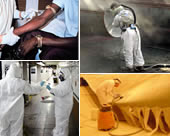
 |
|||
|
|
Health Hazard Evaluations |
|
The National Academies has completed their evaluation of the NIOSH Health Hazard Evaluation (HHE) Program. Based on a scoring system of 1 to 5, with 5 being the highest, the committee rated both the relevance and impact of the HHE Program as 4. The report noted that “If the committee had not been restricted to the use of integers, both scores would have been between 4 and 5.” The report contains eight overarching recommendations addressing strategic planning, outreach to increase awareness about the program, HHE report recommendations, occupational heath capacity building, information transfer, policy impacts, emerging hazards, and public health emergencies. NIOSH will review the panel’s findings and recommendations, develop an implementation plan, and revise the Program’s strategic plan. These materials will be presented to the NIOSH Board of Scientific Counselors and will be available for public comment. The National Academies’ report What is a Health Hazard Evaluation?An HHE is a study of a workplace. It is done to learn whether workers are exposed to hazardous materials or harmful conditions. On the basis of the information you provide, NIOSH responds to an HHE request in one of the following ways:
Who Can Request an HHE?
Private sector and Federal workplacesAn employee can request an HHE if he or she is currently an employee at the workplace of concern and has the signatures of two other employees. If the workplace has three or fewer employees, the signature of only one employee is enough. An officer of a labor union that represents employees for collective bargaining can request an HHE. Any management official may request an HHE on behalf of the employer. For anyone who submits a request, NIOSH will not reveal to the employer the names of the persons who made the request if they indicate this on the request form State or local government workplacesWhen the workplace is part of a State or local government,
NIOSH authority is more limited than for the private and Federal sectors.
The cooperation of the employer may be necessary before NIOSH can do an
evaluation. Should you request an HHE?
1. When to request an HHE from NIOSHYou are an employee, employee representative, or employer and the following apply:
2. When to request help from the OSHA Consultation Program(http://www.osha.gov/dcsp/smallbusiness/consult.html):You are a small business owner and you want:
3. When to file a complaint with OSHA(www.osha.gov/as/opa/worker/index.html):You are an employee and the following situations apply*:
* Employers in the Federal sector may wish to explore the services available through the Division of Federal Occupational Health (DFOH), which maintains an office in each Federal region. State and local government employers may be eligible for help under the OSHA Consultation Program operating in their State. The State or local health department may also be able to help with occupational safety and health issues. How Does NIOSH Respond to an HHE Request?
When NIOSH decides that telephone consultation or a workplace visit is needed, a project officer is assigned. Usually, within 4–6 weeks, the project officer contacts the person who sent in the request. When the request is made by an employee or union, NIOSH also contacts the employer to let them know about the request and to arrange for a site visit. Typically, NIOSH does not conduct surprise visits. What protections are provided for employees who request and participate in HHE investigations?
ConfidentialityIf desired and noted on the HHE request form, NIOSH will not reveal to the employer the names of the persons who made the request. Personal information from records, questionnaires, interviews with NIOSH investigators, and individual medical results will be safeguarded in accordance with provisions of the Privacy Act.
Anti-discrimination ProvisionsThe Occupational Safety and Health Act and the Federal Mine Safety and Health Act forbid employers from retaliating or punishing employees for making HHE requests or cooperating with NIOSH investigators (see Section 11(c) of the Occupational Safety and Health Act or Section 105(c) of the Mine Safety and Health Act). The enforcement of these anti-discrimination provisions is the responsibility of the U.S. Department of Labor. If discrimination is suspected, contact the nearest OSHA or MSHA office immediately.
Procedural Rights of NIOSH and Employee or Employee RepresentativesThere are 7 legal rights of NIOSH and employees or employee representatives that NIOSH considers non-negotiable:
Procedural Rights of the EmployerRegardless of who submitted the request for an HHE, employers have the following rights during HHE investigations:
Role of the Employee RepresentativeThe local, national, or international union may submit an HHE request on behalf of employees it represents. Two employees may authorize a third employee to submit an HHE request on their behalf. The employee representative has the following rights:
How Are HHE Results Reported?
NIOSH reports its findings and recommendations to employers, employees, and employee representatives. Verbal reports are normally provided to employer and employee representatives during a closing conference at the conclusion of a site visit, and by telephone. Often, results are only preliminary or incomplete at that time. Written interim reports are sometimes provided while an investigation is still in progress. When all the information and data have been analyzed, NIOSH issues a report of its final determination, giving findings and recommendations. Copies of this report are sent to the requestor, the employer, employee representatives, OSHA, and other appropriate agencies. The employer is required to post the final report in a place accessible
to employees from all areas evaluated (alternatively, the employer may
give NIOSH names and addresses of affected employees to permit NIOSH to
mail the report to each affected employee.) Although NIOSH has no authority
to force the employer to adopt its recommendations, experience has shown
that most employers attempt to address any problems identified in the
HHE report. By What Authority Does NIOSH Conduct HHEs?
|
||||||||||||||||||||||||||||||||
 |
| Law enforcement officers practicing in a firing range. |
The Law
Section 18 of the Occupational Safety and Health Act (29 USC 667)
permits OSHA to approve a plan under which the State assumes responsibility
for developing and enforcing occupational safety and health standards.
Section 18(c)(6) requires that such a plan, to be approved, must contain satisfactory
assurances that the State will "establish and maintain an effective
and comprehensive occupational safety and health program applicable
to all employees of public agencies of the State and its political
subdivisions." Although approved State plans do not ordinarily
extend the right to request HHEs to State employees and employers,
the State agency charged with carrying out this plan has right-of-access
to State and local government workplaces, and could request technical
assistance from NIOSH in evaluating the workplaces.
Federal Regulations
In cases where NIOSH responds to requests to evaluate State or local
government workplaces, the procedures outlined in 42 CFR 85 are followed.
The NIOSH Health Hazard Evaluation and Technical Assistance Branch provides hands-on, one- and two-month workplace training opportunities to Medical Residents. Residents join staff on a combination of workplace and epidemiologic investigations, public inquiries, health and safety assessments on today's health and safety topics and learn to plan and conduct worksite health evaluations. Residents gain understanding of the role and function of CDC/NIOSH regarding occupational health research and service.
Read more about the Occupational Medicine Rotation Program.
 |
| HHE Home |
| HHE |
| Request
an HHE Solicite una HHE en Español |
| Search for an HHE Report: Tip: Enter Search terms based on topic (e.g. exposure or disease), company name, or HHE number. |
Related Publications: NIOSH Health Hazard Evaluation Program - Short informational brochure NIOSH Health Hazard Evaluation Program - Informational booklet with request form |